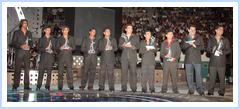How President decided on retaliation
The mood at Temple Trees changed. A grim faced President Mahinda Rajapaksa began receiving a stream of visitors. First to arrive were the two brothers, Basil and Gothabaya. Among those who followed were Minister Rohitha Bogollagama, Deputy Minister Sripathi Sooriyaratchchi and Jathika Hela Urumaya`s Champaka Ranawaka. Moments later, Foreign Minister Mangala Samaraweera, who had first rushed to Colombo`s National Hospital where Lt. Gen. Fonseka was taken for emergency surgery also turned up. They were all gathering in the upstairs lounge.
`I gave him a bullet proof car and warned him to be careful on a number of occasions,` lamented Rajapaksa. He was aware Lt. Gen. Fonseka was a very high profile target and had released a bullet proof BMW car from the Presidential fleet. These vehicles were imported when former President Chandrika Bandaranaike Kumaratunga was in office. The new President opted to distribute them to those who needed these vehicles most. The Army Chief was one of them. Brother Gothabaya intervened to say the Commander used that bullet proof vehicle only when he moved around outside Army Headquarters. For travel within the precincts of the Army Headquarters, he was using a more fuel efficient Peugeot 406.
Soon, the military top brass began to arrive. There were Chief of Defence Staff, the controversial Admiral Daya Sandagiri, Army Chief of Staff Major General Nanda Mallawaratchchi, Navy Commander Vice Admiral Wasantha Karannagoda and Air Force Commander Air Marshal Donald Perera. When they walked upstairs, the politicians realised it was time now for them to walk down. A crisis session of the defence and security top brass began. Views expressed reflected shock, anger and revulsion.
If the Government had grinned and borne the sporadic claymore bomb blasts that took a toll of more than 150 troops since President Rajapaksa was voted to power, here was a more shocking one. A female suicide bomber had not only infiltrated the heavily-fortified Army Headquarters but also badly injured the Commander. There was no doubt in their minds that this was the work of the Liberation Tigers of Tamil Eelam (LTTE). That it came on the eve of the Government wanting to talk peace with them in Geneva exacerbated the anger. In fact, the attack came when the LTTE was meant to be in Geneva for peace talks.
There was a knotty issue that confronted the Government`s top brass. Can the defence and security establishment keep silent in the wake of Tuesday`s attack' Would such stoic silence make Sri Lankans believe the Government was weak, and demoralise its troops' Would the public conclude that even after infiltrating the Army Headquarters and making an attempt on the life of Lt. Gen. Fonseka, the Government was succumbing to terrorist acts and not asserting its right to govern' What was the acceptable level of tolerance' These were just a few of the many questions they sought to find answers to.
It was strongly felt that a limited strike on a guerrilla target was necessary to send the message the Government was not going to remain quiet in the wake of mounting terrorist acts. Its commitment to the Ceasefire Agreement was one thing. An overriding factor and a more important aspect was the exercise of the Government`s sovereignty to demonstrate its ability to respond to major acts of terrorism. It was decided to strike at guerrilla targets in Sampur, overlooking the strategic harbour in Trincomalee and adjoining Mutur. The Air Force would conduct aerial sorties whilst the Army would fire artillery. On the opposite page our Defence Correspondent gives a detailed account of the events of Tuesday.
By then, President Rajapaksa had already recorded his address to the Nation over Rupavahini, the national television network. He was to explain the Government`s position vis-à-vis the second round of talks with the LTTE in Geneva scheduled for three days beginning April 18. He was to tell the nation that despite all the Government`s efforts, the LTTE had not shown a positive response. He ordered that the recording be recalled and a fresh one done. In that he pointedly accused the LTTE of carrying out the suicide attack and added they had unilaterally broken all efforts towards peace. `No type of terrorism will frighten me. I and my Government will not be brought to our knees by whatever challenge that we face,` Rajapaksa declared.
But his message at a critical moment of the nation`s history did not reach some parts of Sri Lanka, or the world. It was not due to enemy action. His army of media experts, considered avowed political loyalists, had thought it fit to distribute the text only the next day. This was how best they could treat the issue. And all this, while some western media, especially the BBC, was on a trip about the casualties and displacement because of the aerial bombings at Sampur.
That same Tuesday evening, Rajapaksa chaired a poorly attended emergency Cabinet meeting. One would have thought that the 40 something Cabinet would have been over-flowing, but most Ministers had not turned up. It seemed that the incident at Army Headquarters had made them think twice about travelling on the road. He told those present that he had remained very tolerant with the LTTE despite their orgy of violence. Now they have brought the war to Army Headquarters. He had ordered strikes on guerrilla targets, he told them. Foreign Minister Mangala Samaraweera cautioned that it would have a snowballing effect since there would be counter attacks. However, the Minister added that the Government would have to face all of them.
But late that same day Samaraweera had received an urgent telephone call from his British counterpart. Foreign Secretary Jack Straw had inquired about the Air Force bombings and expressed his Government`s concerns over civilian casualties. That call came so fast from London that some of the Israeli-built Kfir intercepter jets had not even returned to base at Katunayake after their mission. He knew of civilian casualties even before the sorties had returned. But the irony of it was that our own Foreign Minister seated in Colombo did not know about the bombing raids, and promised to get back to Straw with the details. It was only at the evening`s Cabinet meeting that Samaraweera in Colombo knew what Straw in London was privy to.
A Foreign Office wag was to say that Samaraweera was stuck for a reply, not so much because of the fact that he did not know what was happening in his own backyard in Sampur, but that he was confused if Straw had got his wires-crossed and thought he was speaking to one of his air commanders in Iraq.
Had Straw at lease mentioned the blatant act of terrorism at Army Headquarters that nearly took the life of the Commander, Samaraweera might have known he was talking of the situation in Sri Lanka.
The Foreign Minister was not alone in being in the dark about the Sampur bombings. A foreign correspondent had telephoned Media Minister Anura Priyadarshana Yapa that Tuesday afternoon to ask for his response on aerial raids by the Air Force. He was unaware too.
`What bombings'` seemed to be the general response from Government heads, including the many spokesmen on the subject on war and peace. After Minister Yapa made inquiries, the Information Department put out a news release. It said:
`Following the suicide bomb attack on the Army Commander this afternoon, the Liberation Tigers of Tamil Eelam (LTTE) positioned in the Sampur area launched an attack on the Navy in Trincomalee. The security forces have carried out an operation to deter further attacks by the LTTE.`
The Government`s media responses to Tuesday`s incident at Army Headquarters seemed a muddled up circus than a focused one. Many who were `spokesmen` spoke in different voices on the day of the incident and the days that followed. The contradictions no doubt created serious questions for Government`s credibility. One was the remarks by Military Spokesman Brigadier Prasad Samarasinghe to the Reuters news agency that claymore mine blasts would not provoke air attacks. Senior military officers were irked that the remarks were offensive to ground troops who were made to feel that attacks on them were a different matter. Ironic enough, they wanted their own spokesman to say less and save them greater heartburn. Officials at the Ministry of Defence expressed the same sentiment.
They asked whether it was not the prerogative of the Defence Secretary or the Ministry of Defence to make such comments, or have one Government spokesman. Another sad saga came after President Rajapaksa had appealed to Editors and News Directors of electronic media to act with restraint. He said there was a need to report on sensitive issues with care to ensure there was no communal backlash. But even before those who took part in the meeting could reach their offices, something shocking had arrived.
The Information Department had distributed via computer gory pictures of Sinhala civilians massacred in Gomarankadawala in the Trincomalee district. Of course those who see the lighter side of every situation remarked that this must be the Government`s way of providing dis-information, and thereby confusing the enemy. Either way, those acting as spokesmen for the Government were shooting themselves in the foot in the propaganda war against Tiger guerrillas. Ironically, nothing seems to have been done to cure this malady that has lasted through successive governments, from the inception of the Eelam struggle. Though there was more international support and acknowledgement now than before for the Government, it is still unable to get its message across in a crisis situation.
Hard on the heels of the poorly-attended Cabinet meeting, President Rajapaksa had a meeting with party leaders. Though a delegation from the opposition United National Party was invited to take part in this meeting at 6 p.m, acting leader Karu Jayasuriya had preferred a separate bi-lateral meeting with a delegation from his party. They were told to come at 8 p.m.
Among those taking part in the party leaders meeting were Ministers Nimal Siripala de Silva, Jeyaraj Fernandopulle, Dinesh Gunawardena, Susil Premajayantha, Janatha Vimukthi Peramuna`s (JVP) Tilvin Silva, Wimal Weerawansa, Anura Dissanayake, Jathika Hela Urumaya`s (JHU) Ven. Athureliye Rathana, Eelam People`s Democratic Party leader Douglas Devananda, Ceylon Workers Congress leader Arumugam Thondaman and National Unity Alliance leader Ferial Ashraff.
Rajapaksa told party leaders he was not bent on going to war. He said they (the LTTE) brought the war to Army Headquarters and a limited response therefore became necessary. He wanted the parties that were supportive of the Government to appreciate the situation and extend their support. JVP`s Tilvin Silva was the first to respond. He said President Rajapaksa would have the fullest backing of the JVP. Ven. Athureliya Rathana expressed similar sentiments and pointed out what he thought were security lapses in the City of Colombo.
Around 8 p.m. that Tuesday night a UNP delegation arrived at Temple Trees for their meeting with Rajapaksa. Earlier, acting leader Karu Jayasuriya had telephoned UNP leader Ranil Wickremesinghe in the United States to brief him and obtain clearance. The latter had told him to go ahead. Accompanying Jayasuriya were Tissa Attanayake, Milinda Moragoda and Jayalath Jayawardena.
Jayasuriya said that the UNP`s unstinted support was on offer for the Government to curb violence. But, he pointed out, equally firmly, that members of the UPFA were overtly critical of the UNP and were making all forms of accusations. He made pointed reference to a talk show where Sripathi Sooriya-ratchchi had blamed the UNP for signing the Ceasefire Agreement and the prevailing situation. This was quoting newspaper reports. In the show in question, Sooriyaratchchi had made references to The Sunday Times too. President Rajapaksa pointed out `the media do not behave the way I want them to`, and ducked the issue.
Moragoda who was referring to Tuesday`s incident at Army Headquarters urged Rajapaksa to seek the help of the United States Government -- the panacea for all ills, according to the Moragoda doctrine. This was to obtain the help of American investigators to probe the incident and identify how it occurred. The President nodded his head in a way one was not sure if it meant `yes`, or `no`.
After the meeting ended, President Rajapaksa found there were more visitors to Temple Trees. Sripathi Sooriya-ratchchi was in the company of Ministers John Seneviratne and Pavithra Wannia-ratchchi. `What you said on the talk show has hit them (the UNP) badly,` said Rajapaksa. He said Sooriyaratchchi should not be too harsh on them since they were now supporting the Government`s acti-ons against violence by Tiger guerrillas. The Deputy Minister replied `if you say so, I will not.`
It was nearing midnight but Rajapaksa`s tasks were not over. He drove thereafter to the National Hospital where emergency surgery had just been concluded on Lt. Gen. Fonseka. He egged on the medical staff `I would like you all to ensure a quick recovery for him.`
The next day (Wednesday) Foreign Minister Samaraweera addressed heads of the Colombo based diplomatic community. Some raised issue over the Sampur air raids and the fate of internally displaced persons. This time Samaraweera was prepared. An official announcement from the Government said the population in Sampur was 16,500 and only a fraction had been affected. But a United Nations High Commissioner for Refugees (UNHCR) statement declared there were 7000 to 8000 persons displaced. Samara-weera said the air raids were only a limited response to the suicide attack on the Army Commander.
Soon after that meeting, Samara-weera met Jon Hanssen Baur, Norway`s Special envoy for the peace process and their Ambassador in Sri Lanka Hans Brattskar. He urged them to pressurise the LTTE to return to Geneva. Even before Tuesday`s incident, he said, the Government had offered the LTTE the use of a sea plane (owned by SriLankan Airlines) and even agreed to meet the costs. However, there were still problems including the issue of where such a plane should land with LTTE`s eastern leaders. Whilst the LTTE favoured the Iranamadu irrigation tank, the Government preferred a lake near Wanni located in a Government-controlled area.
Later that day, President Rajapaksa met with envoys of the donor co-chair countries individually. He explained that the air raids were a limited response and gave the reasons why it became necessary. All envoys condemned the suicide bomber attack at Army Headquarters.
Another visitor was Indian High Commissioner Nirupama Rao. She was to politely convey her Government`s concerns over the air raids. She said such action would lead to the influx of refugees to South India. With local elections in Tamil Nadu due next week, such a move would become damaging to the ruling Congress Party Government in New Delhi. President Rajapaksa said it was only a limited offensive and it was now over. Indian Prime Minister Manmohan Singh also telephoned President Rajapaksa to inquire about the prevailing situation. He reiterated his commitment to help the Government in protecting Sri Lanka`s sovereignty and territorial integrity.
Rajapaksa sought Premier Singh`s assistance to urge the Indian Navy to curb attempts by LTTE to smuggle military hardware through high seas into Sri Lanka. The Indian prime Minister assured this would be done.
There was a fuller turnout of Cabinet ministers for Wednesday`s weekly meeting. Rajapaksa took the opportunity to explain matters relating to the air strike, in greater detail. There was also a meeting of the National Security Council where it was decided to ban May Day rallies in the Colombo district on grounds of security.
President Raja-paksa had a meeting with a JVP delegation the same day. Taking part were Tilvin Silva, Wimal Weerawansa and Anura Dissanayake. Associated with the President were Dulles Allahaperuma MP, and presidential secretary Lalith Weeratunga. The outlines of a resolution at Friday`s all-party conference over peace talks and the need to curb violence were discussed.
The resolution came up at the all-party talks on Friday. Though the UNP delegation was at first reluctant to sign without winning the approval of the party, but later with a series of amendments, the joint resolution was unanimously adopted.
An equally important decision was made at the meeting of donor co-chairs in Oslo on Friday. A statement said the Co-chairs reiterated their deep concern at the recent deterioration of the situation in Sri Lanka, condemning all acts of violence and calling on this to stop.
Though the meeting gave rise to widespread speculation that talks were due to resume soon, the reality was sadly different. True enough, both the Government and the LTTE have committed themselves throughout this week to uphold the ceasefire.
There is strong evidence the LTTE is busy making preparations for a major attack. This has prompted the Government to ensure greater military preparedness. With fears of a return to Eelam War IV ominous, many may wish a Geneva meeting is round the corner. The immediate prospects are clearly dim. This is notwithstanding all the soothsaying going on about talks in Geneva.





















